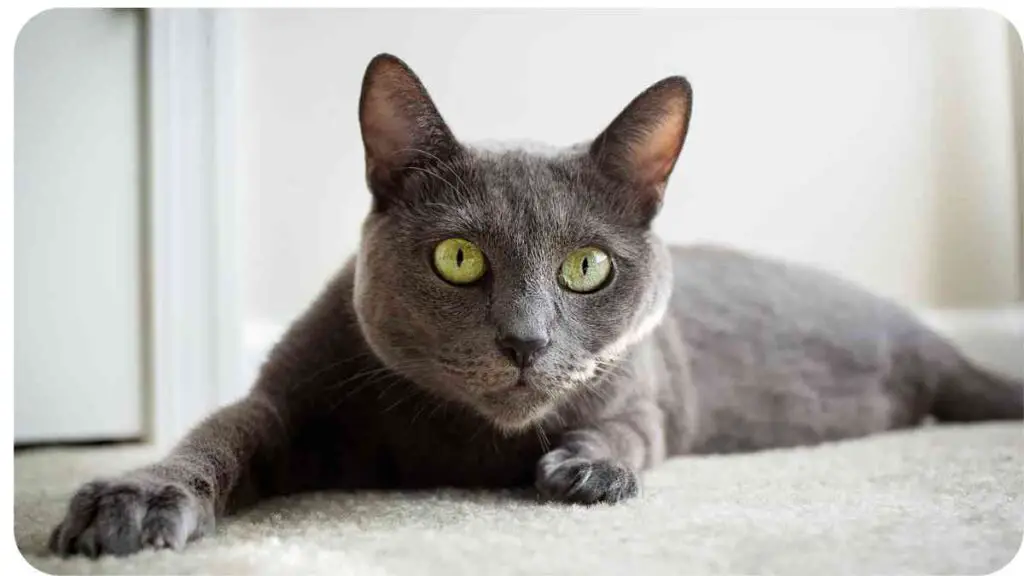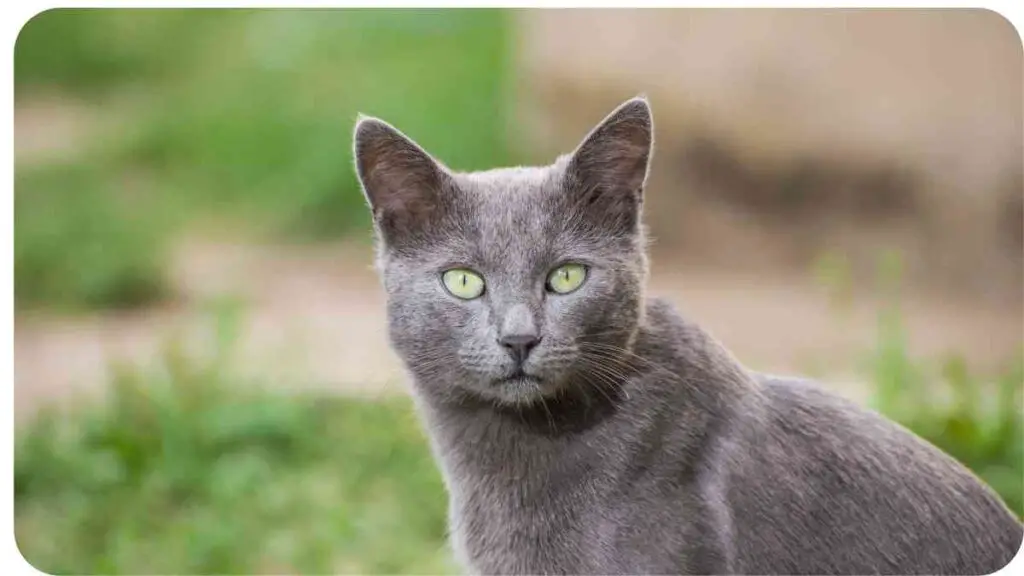Russian Blue cats are cherished companions, but their behavior can be complex. This updated article sheds light on common misconceptions, focusing on jealousy and aggression.
Learn to recognize signs, understand causes, and discover effective strategies to foster a harmonious relationship with your Russian Blue.
| Takeaways |
|---|
| Russian Blue cats may exhibit signs of jealousy towards their owners. |
| Jealousy in cats can manifest through behaviors like attention-seeking, territoriality, or aggression. |
| Providing proper socialization, attention, and playtime can help alleviate jealousy in Russian Blue cats. |
| Creating a secure and enriching environment for your Russian Blue cat can reduce feelings of jealousy. |
| Understanding your cat’s individual needs and providing love and reassurance can strengthen your bond and minimize jealousy. |
Are Russian Blue Cats Prone to Jealousy? Understanding Feline Dynamics

It is natural for cats to experience moments of jealousy, particularly in multi-pet households. Russian Blue cats, recognized for their territorial nature, may display signs of jealousy when they perceive a lack of attention from their human companions.
This innate territorial instinct can trigger feelings of insecurity, prompting jealousy towards other pets in the home. Recognizing and addressing these emotions is essential for fostering a balanced and contented environment for both the Russian Blue and their human family members..
Are you wondering how much a Russian Blue kitten should weigh? In the early months of their lives, it’s important to monitor their weight to ensure healthy growth. Check out our guide on how much a Russian Blue kitten should weigh to learn about the ideal weight range and ensure your kitten is thriving.
Detecting Jealousy in Your Cat
If you share your home with multiple pets, it’s not uncommon for one of them to feel a twinge of jealousy towards a more favored companion. In such cases, observe your Russian Blue cat for subtle cues indicating jealousy. Should jealousy arise, consider dedicating extra playtime and affection to the envious feline, reassuring them of your love.
Similarly, the introduction of a new baby can trigger attention-seeking behavior in your Russian Blue. To mitigate potential acting out, ensure consistent attention and affection during this transitional period, helping your cat adapt positively to the changes.
Owners of Russian Blue cats should be aware that their distinct fur color may contribute to feelings of jealousy. When a new pet enters the household, offering equal attention and affection can help alleviate any potential jealousy.
Furthermore, be mindful of new individuals entering your life who show a keen interest in bonding with your Russian Blue. Whether it’s shared walks or play sessions, such interactions might trigger jealousy. Counteract this by involving your cat in these activities, reinforcing a sense of inclusion and preventing potential aggressive responses.
Addressing Your Cat’s Jealousy
Suspecting jealousy in your cat requires a thoughtful approach to identify and address the underlying causes. If another pet in the household triggers jealousy, dedicate additional quality time to your cat. Engage in calming activities together, reaffirming your bond and reassuring the feline of their significance in your life.
When jealousy is directed towards a specific person, consider subtle adjustments. If scents, such as strong perfumes or colognes, seem to be a point of contention, kindly ask the individual to refrain from using those scents around the house. Creating an environment that minimizes potential triggers can contribute to a more harmonious coexistence.
In uncertain situations, seeking professional guidance is a wise choice. Consult with an experienced animal behaviorist to gain insights into your cat’s unique needs and emotions. These experts can provide tailored advice, ensuring a nuanced and effective approach to each specific situation.
| Possible Actions | Description |
|---|---|
| Gradual Introductions | Introduce the new pet or person slowly, allowing your cat to adjust at their own pace. |
| Separate Resources | Provide separate resources like food bowls, litter boxes, and sleeping areas to avoid competition. |
| Individual Attention | Spend quality one-on-one time with your jealous cat to reassure them and strengthen the bond. |
| Enrichment and Distractions | Offer interactive toys, scratching posts, and engaging activities to keep your cat mentally and physically stimulated. |
| Positive Reinforcement | Reward your cat’s good behavior and positive interactions with treats, praise, or playtime. |
| Seek Professional Help | Consult with a veterinarian or animal behaviorist for additional guidance and support if the jealousy persists. |
Managing Jealous Behavior in Your Cat
To effectively address your cat’s jealous behavior, begin by identifying the root cause. Is the jealousy stemming from perceived favoritism towards another pet, or is it triggered by the presence of a new person in your life?
Evaluate the feasibility of altering the situation. If your cat is jealous due to unequal attention among pets, consider adjusting your daily routine to spend more quality time with the affected feline. Paying extra attention to your cat’s emotional needs can alleviate loneliness and sadness, reinforcing their sense of importance.
However, recognizing that changing certain situations may be challenging, especially due to work commitments, prompts the need for alternative strategies. Explore ways to make your pet feel valued and secure despite the circumstances. This may involve incorporating additional enrichment activities, interactive toys, or creating designated cozy spaces to enhance their overall well-being.
If uncertainties persist or the situation becomes more complex, seeking guidance from a veterinarian or animal behaviorist is a prudent step. These professionals can offer tailored advice, considering your cat’s unique personality and circumstances, ensuring a holistic and effective approach to managing jealousy.
Curious about the average lifespan of Russian Blue cats? These elegant felines are known for their longevity. Discover more about the factors that contribute to a Russian Blue cat’s lifespan in our article on how long Russian Blue cats live, and gain insights into providing them with a healthy and happy life.
Understanding Feline Jealousy in Multi-Pet Homes
Cats, inherently territorial beings, place immense importance on their environment. Introducing another pet, be it a cat or a dog, can disrupt this territory, causing discomfort for your Russian Blue or any cat. The challenge lies in managing their natural aversion to change.
Cats, by nature, are competitive and prefer to be the primary focus in their home. In multi-pet households, it becomes crucial to demonstrate equal care and attention to each pet, eliminating any perception of rivalry for your affection.
If your Russian Blue exhibits signs of jealousy towards a new pet:Spend additional quality time with your Russian Blue during the initial introduction period to reaffirm your love and attention.
Offer extra attention to reassure your cat of their esteemed position as the primary companion at home.
Understanding Feline Jealousy

Jealousy is a common emotion in cats, manifesting as a form of aggression. Due to their territorial nature, cats, including Russian Blue breeds, are naturally inclined to assert dominance and protect their space.
For a Russian Blue cat, territoriality is deeply ingrained, and any perceived threat to their domain can trigger jealousy. Even the presence of other pets, people, or objects within their territory may elicit a jealous response as they strive to maintain their perceived rightful place.
In the feline world, giving an inch is often interpreted as a concession of territory, prompting a cat, particularly a Russian Blue, to assert their dominance. Understanding and acknowledging this instinctive behavior is crucial for pet owners to navigate and manage jealousy effectively, promoting a balanced and contented environment for their feline companions.
| Points to Consider | Description |
|---|---|
| Common Emotion | Jealousy is a common emotion in cats. |
| Behavioral Indicators | Signs of jealousy may include attention-seeking, territorial behavior, and aggression. |
| Individual Variation | Jealousy levels can vary among cats based on personality, past experiences, and socialization. |
| Triggers and Context | Jealousy can be triggered by changes in routine, introduction of new pets, or attention diversion. |
| Management and Prevention | Providing individual attention, enrichment, and gradual introductions can help manage and prevent jealousy. |
Decoding Russian Blue Cat Behavior
Russian Blue Cats are generally not inherently aggressive, but like any cat, they may exhibit aggression when frightened or feeling threatened. Understanding the triggers and recognizing signs of aggression is vital for maintaining a peaceful household.
Observing Body Language: A key indicator of a Russian Blue’s emotional state is their body language. If your cat displays ears pulled back and a raised tail, these signs suggest feelings of anxiety or insecurity. By closely observing their non-verbal cues, you can gain insights into their emotional well-being.
Identifying Aggression: Hissing or growling at other pets or people in the household is a clear sign of aggression in a Russian Blue. Recognizing these behaviors promptly allows for timely intervention, preventing potential conflicts.
Managing Aggressive Episodes: If aggression occurs, swift action is essential. Separate the involved parties immediately to eliminate the risk of physical altercations. Providing a safe space for each cat and allowing them time to calm down can help diffuse tension.
Dealing with cat shedding can be a common concern for pet owners. If you own a Russian Blue cat and want to know more about their shedding habits, we’ve got you covered. Dive into our article on how much Russian Blue cats shed to learn about their grooming needs and tips to manage their shedding effectively.
Addressing Aggression in Your Russian Blue Cat
As a Russian Blue cat owner, if you’ve observed aggression towards other pets or people in your household, it’s crucial to address the underlying causes effectively.
Understanding Jealousy and Territorial Behavior: Russian Blues, known for their territorial instincts, may express jealousy towards other pets and people, leading to aggression. Recognizing these emotions is the first step in managing their behavior.
Identifying Territorial Marking: Aggressive behavior in Russian Blues might manifest through territorial marking, such as urinating on furniture or walls. This could signal their attempt to establish dominance. Understanding the motive behind this behavior is essential for effective intervention.
Promoting a Unified Household: To tackle aggression, it’s vital for everyone in the household to understand the reasons behind the cat’s behavior. Collaborative efforts can then be directed towards creating a supportive and unified environment, minimizing stressors that contribute to territorial disputes.
Proactive Measures: Consider strategies to prevent territorial conflicts, such as providing ample resources like scratching posts and ensuring separate spaces for each pet. Engaging in interactive play with your Russian Blue can redirect their energy positively.
Consulting with Professionals: If aggression persists, seeking guidance from a veterinarian or animal behaviorist is recommended. These experts can offer personalized advice, taking into account your cat’s specific circumstances, and provide effective strategies to address aggression.
If you’re considering adding a Russian Blue cat to your family, it’s essential to understand the potential costs involved. Our informative article on how much Russian Blue cats cost provides insights into the factors that influence their price range, helping you make an informed decision and budget accordingly.
Understanding Aggression in Russian Blue Cats

Russian Blue cats, known for their intelligence and independence, can display aggression, often rooted in their unique temperament and emotional sensitivity.
Independent Nature: Russian Blues are inherently independent cats, and if you’re seeking a lap cat, this breed may not align with that preference. Their independent nature means they may not constantly seek physical affection, and understanding this characteristic is essential for a positive owner-cat relationship.
Jealousy and Aggression: Russian Blues can exhibit aggression, particularly when they perceive unequal attention among pets in the household. In multi-cat households, jealousy may escalate, leading to aggressive behavior, even among members of the same breed.
Depression and Aggression: These cats are sensitive, and if they feel they don’t fit into their surroundings or struggle to connect with other cats, it can lead to depression. Depression, in turn, may manifest as aggression, emphasizing the importance of creating a supportive and inclusive environment.
Managing Aggression in Russian Blues: To address aggression, ensure each cat receives individual attention, and provide a stimulating and enriching environment. Monitoring their emotional well-being, especially in multi-cat households, is crucial for preventing potential conflicts.
Considerations for Families: While Russian Blues make wonderful companions, their small size and high energy levels may not be suitable for households with children. Understanding their unique needs and adjusting the environment accordingly can contribute to a harmonious relationship.
| Possible Causes | Description |
|---|---|
| Fear | Russian Blue cats may become aggressive due to fear or perceived threats. |
| Stress | High levels of stress or anxiety can trigger aggression in Russian Blue cats. |
| Lack of Socialization | Insufficient socialization during kittenhood can contribute to aggressive behavior. |
| Medical Issues | Underlying medical conditions can cause pain or discomfort, leading to aggression. |
| Environmental Factors | Unfamiliar or uncomfortable environments can provoke aggression in Russian Blue cats. |
| Resource Guarding | Russian Blue cats may exhibit aggression when protecting their territory or resources. |
| Interactions with Humans | Negative experiences or mishandling by humans can result in defensive aggression. |
| Interactions with Other Cats | Conflict with other cats, both within the household or outside, can lead to aggression. |
Distinguishing Jealousy from Aggression in Cats
Recognizing the disparity between jealousy and aggression is crucial for cat owners, as these emotions manifest differently in feline behavior.
Jealousy Defined: Jealousy in cats is characterized by feelings of anger, hatred, disgust, or resentment, stemming from the cat’s perception of another pet or person as a threat to its relationship with the owner. Observable behaviors may include hissing, hiding, unprovoked attacks, scratching at doors, and seeking refuge under furniture. These actions aim to express discontent and secure the owner’s attention.
Aggression Defined: Aggression, as per Dictionary.com, refers to hostility or ill will directed against those perceived as differing from or threatening the group. In the context of cats, aggression may manifest as confrontational behaviors, such as hissing, growling, swatting, or even physical attacks. Unlike jealousy, aggression is a broader reaction to perceived threats, not solely focused on protecting the owner’s attention.
Specific Scenarios in Russian Blues: Russian Blue cats may exhibit signs of jealousy, particularly in situations where a new pet, such as a kitten, is introduced to the household. The perceived threat to their exclusive relationship with the owner can trigger both jealous and aggressive behaviors. Recognizing these signs allows for targeted intervention to address the underlying emotions.
Have you ever wondered about the origins of Russian Blue cats and the breeds that contributed to their development? Our comprehensive guide on what breeds make a Russian Blue cat explores their fascinating lineage and sheds light on the ancestry that led to the creation of these stunning and affectionate cats.
Conclusion
If you find yourself concerned about your Russian Blue cat displaying signs of aggression or jealousy, fret not. Addressing these behaviors requires a thoughtful and proactive approach to ensure a safe and contented household.
Tips for a Harmonious Environment:
- Individual Attention: Dedicate quality time to each pet, addressing their unique needs and reinforcing their sense of importance.
- Enrichment Activities: Introduce interactive toys, scratching posts, and engaging activities to keep your Russian Blue mentally and physically stimulated.
- Unified Understanding: Foster a collective understanding among household members about the cat’s behavior and implement collaborative strategies to create a supportive environment.
- Professional Guidance: If challenges persist, consider seeking advice from a veterinarian or animal behaviorist. Their expertise can provide tailored solutions for your Russian Blue’s specific needs.
Further Reading
Here are some additional resources for further reading on related topics:
Do Cats Get Jealous?: Explore the concept of jealousy in cats and learn about common behaviors that may indicate jealousy in your feline companion.
Do Russian Blue Cats Get Along with Other Cats?: Discover how Russian Blue cats typically interact with other feline companions and gain insights into their compatibility with other cats in a household.
Can You Leave Your Russian Blue Cats Alone?: Find out about the independence level of Russian Blue cats and learn how they cope with being left alone for extended periods, along with tips for providing them with a stimulating environment.
FAQs
Here are some frequently asked questions about Russian Blue cats:
Do Russian Blue cats require a lot of grooming?
Russian Blue cats have short and dense fur that requires minimal grooming. Regular brushing to remove loose hair and occasional nail trims are usually sufficient to keep their coat and claws in good condition.
Are Russian Blue cats hypoallergenic?
While no cat breed is completely hypoallergenic, Russian Blue cats are often considered to be more hypoallergenic compared to other breeds. They produce fewer allergenic proteins in their saliva, which may reduce allergic reactions in some individuals.
How do Russian Blue cats behave with children?
Russian Blue cats are generally known for their gentle and reserved nature, making them suitable companions for children. However, it’s important to supervise interactions between young children and cats to ensure mutual respect and prevent accidental harm.
Are Russian Blue cats prone to any specific health issues?
Russian Blue cats are generally considered a healthy breed with no specific genetic predispositions to major health problems. However, like all cats, they can still experience common feline health issues such as dental problems, obesity, and urinary tract issues.
How long do Russian Blue cats live on average?
Russian Blue cats have a relatively long lifespan compared to some other breeds. On average, they can live anywhere from 15 to 20 years or even longer with proper care, a balanced diet, regular veterinary check-ups, and a safe environment.

I’m Dr. Hellen James, a veterinarian who has spent her career working with cats and has seen firsthand how important it is to understand each breed’s unique needs.


